Translated and Sourced from Mizuki Shigeru’s Mujyara, Japanese Wikipedia, Japan Times, OnMark Productions, and Kaii Yokai Densho Database
To learn more about Japanese Ghosts, check out my book Yurei: The Japanese Ghost
Who’s got big balls? Tanuki have big balls! Anyone who has seen Studio Ghibli’s Pom Poko (Heisei Tanuki Gassen Pom Poko) knows that tanukis’ nut sacks are capable of amazing magical feats—from being stretched out into giant tarpaulins to transforming into magical treasure ships. And the Japanese people aren’t shy about their love for tanukis’ giant balls; images of well-endowed tanuki can be seen all over Japan, from ubiquitous statues in from of shops and restaurants to bank commercials to anime to … pretty much anything.
What Does Tanuki no Kintama Mean?
Tanuki (狸) gets mistranslated into English as all sorts of things, mostly badger or raccoon or the neologism “raccoon dog.” None of these really fit. Badgers (穴熊; anaguma) and raccoons (洗熊; araiguma) have their own Japanese names. “Raccoon dog” doesn’t really mean anything, so I personally just like sticking with the Japanese name—tanuki works better than anything else.
Now those giant balls …
The common Japanese word for testicles is kintama (金玉), which translates literally as “golden” (金; kin) + “balls” (玉; tama). In Japan, large testicles (or a large scrotum, to be precise. It’s the nut sack, not what’s in it that matters.) are a symbol of wealth and prosperity, not sexual prowess. An alternate name, kinbukuro (金袋; money bags), makes the connection even stronger. Even more so when you consider that tanuki scrotums were once sewn into wallets and carried as literal “money bags.”
And while kintama might just be slang, in the tanuki’s case these “golden balls” have a historical precedence.
Traits of the Tanuki
As yokai, tanuki are known to have several magical powers and interesting traits. They are henge, shape-shifters, with abilities on par with and sometimes even exceeding those of kitsune (foxes), the most powerful of Japan’s magical animals. Tanuki are also famous for their belly drums (See the Belly Beating of the Tanuki) and their love of sake, food, and generally being the lazy, loafing tricksters of Japanese folklore. And their giant balls.
But they weren’t always like this. The familiar tanuki that we know today—with the prodigious belly, straw rain hat, sake bottle, and pendulous testacles—is a relatively modern invention. It actually comes from the 20th century.
Early depictions of tanuki show a realistic animal. Japanese tests are almost completely mum on tanuki for most of history. There is mention of the mujina (狢), a mythical animal associated with the tanuki in some areas, from around the 8th century.
Tanuki appeared in early encyclopedia starting from the 1600s, like the 1666 Kinmōzui ( 訓蒙図彙; Collected Illustrations to Instruct the Unenlightened) by Nakamura Tekisai (中村惕斎). These early works are only collections of animals, and rarely mention tanukis’ supernatural powers. One of the earliest mentions of a tanuki as a magical creature comes from the Wakan Sansai-zue (和漢三才図会; Illustrated Sino-Japanese Encyclopedia) compiled by Terajima Ryōan (寺島良安), a doctor from Osaka. The tanuki entry does not go into detail, but states that “like a kitsune (fox), an old tanuki will often transform into a yokai.”
Toriyama Sekien (鳥山石燕) included tanuki in his 1776 Gazu Hyakkiyakō (画図百鬼夜行; Illustrated Night Parade of 100 Demons), but again this tanuki looks like a regular animal.
The depiction of tanukis evolved slowly, with new stories adding new elements and transforming them slowing from the realistic animals to the cartoonish figured seen all over Japan today. The big round stomach and accompanying belly-drumming didn’t become attacked to tanuki lore until the 18th century. Several stories of tanukis’ belly-drumming appear around this time, although their famous nut sacks are still regular size. They didn’t develop elephantitis until later.
The reason for the appearance is gold.
Gold Nut Sack Pounding
Owaka Shigeo traced the origins of tanukis’ magical scrotums in his book about Japanese metal working, Hagane no Chishiki (鋼の知識; Knowledge about Steel). He claims the myths began from goldsmiths and metalworkers in Kanazawa prefecture. In order to turn malleable gold into delicate gold leaf, they would wrap the gold in animal skin and pound it into thin sheets. They discovered that a certain part of a certain animal was the best for the business.
In biological terms, tanuki scrotums are rather large. This is an evolutionary trait to help the randy males succeed in the fierce competition for mates. And from a metalworking perspective, tanuki scrotums were both soft and strong enough that they could take the heavy pounding and stretch out to extraordinary size. It was said that, using a tanuki scrotum, even a small piece of gold could be stretched out into an 8-tatami mat big sheet of gold leaf. (Some said a 1000-tatami mat sheet, but that seems excessive.)
Because of this, tanuki scrotums became known for their ability to “stretch” money and make it go further. Savvy marketers started telling tales of the magical properties of tanuki scrotums, selling them as good luck charms and wallets telling buyers that the scrotums would “expand their wealth” in the same way they stretched nuggets of gold into massive sheets.
This association between wealth and tanuki testicles continues to this day. In modern times, Tanuki are said to embody “Eight Virtues,” with their large scrotums signifying luck with money.
Ukiyo-e Artists and Tanuki Balls
Once the myth of tanuki and their magical, giant balls hit the cities, the imagination of Edo period artists went wild. It really was too good of an idea, and made much too interesting of a motif, so artists expanded on the “stretching scrotum” idea. Suddenly, tanuki were using their nut sacks as weapons, sail boats, swimming pools, fishing nets, umbrellas … there was no limit. All of the great artists of the ukiyo-e period got in on the fun, out doing each other with even more outrageous pictures of tanukis’ magical scrotums.
Utagawa Kuniyoshi did a particularly cool set of tanuki testicle prints that you can see here.
It was thanks to ukiyo-e artists that the idea of tanuki and their magical, giant balls became a permanent part of Japan’s folklore and popular culture. In fact, I think it shows that the addition was more of an artistic one than a storytelling one—there are many Edo period stories about tanuki, but most of them focus on either shape-shifting or belly-drumming. I have read few tanuki tales where their scrotums play a significant element to the story.
All the Rest
The rest of the tanukis’ outfit—the straw hat, sake jug, and pay slip—didn’t show up until even more recently. The iconic image of the tanuki that we know and love today is really a product of the Taisho era (1912-1926), when more and more shops started using tanuki for advertising or as statues out in front of their shops.
Translator’s Note:
This article was largely sourced through the amazing website OnMark Productions. Anyone who wants to know everything about tanuki (and other aspects of folkloric and Buddhist Japan) should make that site their destination. I got most of my information from there, and only used additional sources to confirm and add a bit of flavor to the article.
Further Reading:
For more tales of tanuki, check out:
The Belly-Beating of the Tanuki







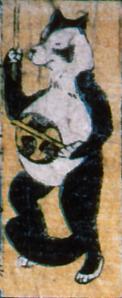

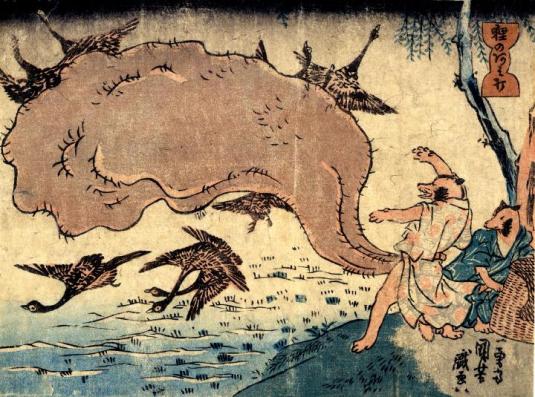


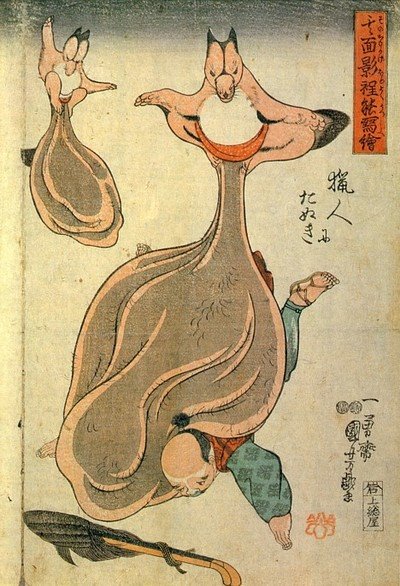


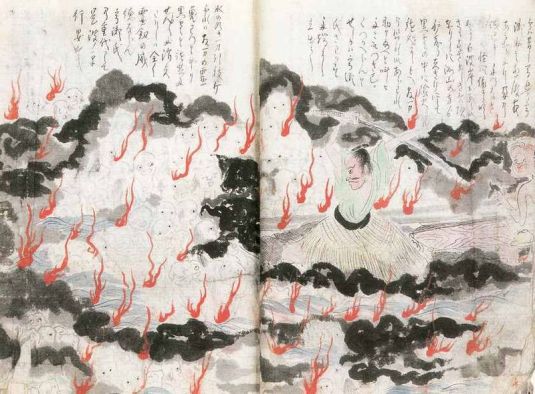

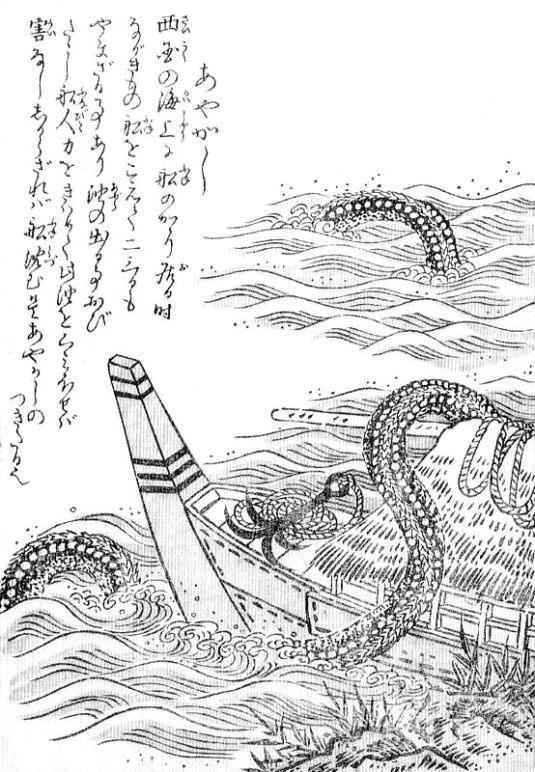

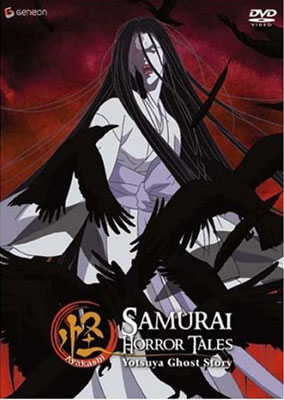


Recent Comments